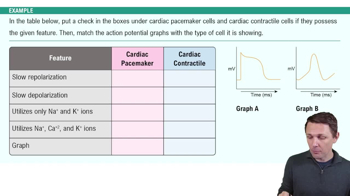Cardiac Action Potentials definitions Flashcards
 Back
BackCardiac Action Potentials definitions
1/15
Terms in this set (15)
- Pacemaker cellsHeart cells that set the rhythm through autorhythmicity, initiating action potentials without external signals.
- Contractile cellsHeart cells responsible for contraction and blood pumping, experiencing rapid depolarization and a plateau phase.
- DepolarizationA phase where the cell's membrane potential becomes less negative, often due to sodium or calcium ion inflow.
- RepolarizationThe process of restoring the cell's membrane potential to a negative value after depolarization.
- Plateau phaseA phase in cardiac action potentials where depolarization is prolonged due to calcium inflow and potassium outflow.
- AutorhythmicityThe ability of pacemaker cells to generate action potentials independently, setting the heart's rhythm.
- Sodium ionsPositively charged ions that contribute to depolarization by entering the cell.
- Calcium ionsPositively charged ions that prolong depolarization in cardiac cells by entering the cell.
- Potassium ionsPositively charged ions that contribute to repolarization by exiting the cell.
- Absolute refractory periodA period during which cardiac cells cannot respond to new action potentials, ensuring relaxation.
- Pacemaker potentialThe slow depolarization phase in pacemaker cells that initiates action potentials.
- Intrinsic cardiac conduction systemThe system responsible for initiating and spreading action potentials throughout the heart.
- Gap junctionsChannels that allow action potentials to pass directly from one cardiac cell to another.
- MillivoltsA unit of measurement for electrical potential used to describe changes in membrane potential.
- Resting potentialThe stable, negative membrane potential of a cell when it is not being stimulated.



